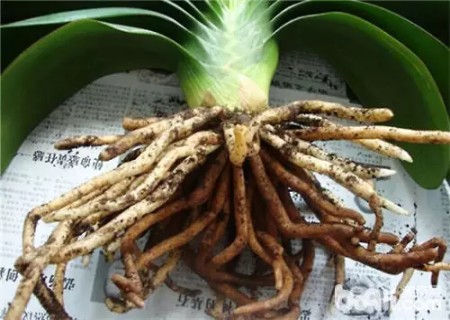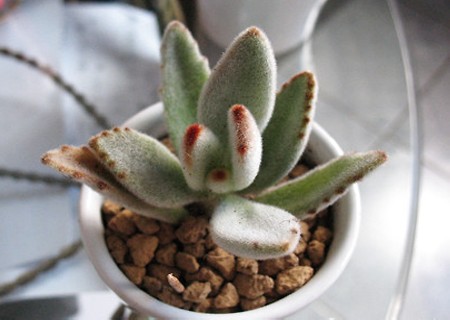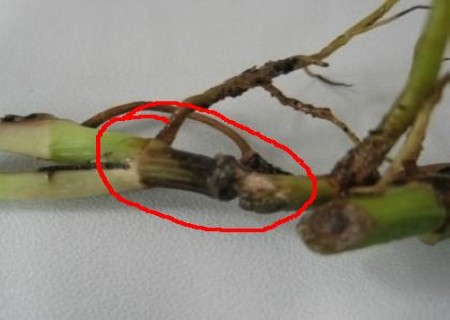What about the rotten roots of potted flowers?
Because of uncontrolled watering, improper fertilization and poor management, potted flowers are often easy to cause rotten roots, which destroys the flowers carefully cultivated for years or even decades, which is really a pity. If accurate diagnosis can be made in the early and middle stages of rotting roots, and effective measures can be taken, it is expected to avoid the death of some flowers.
We should treat plants with rotten roots differently, such as succulent plants, orchids, woody plants, herbaceous plants, and so on. Individual varieties are also involved in these major categories, and not all plant rotting roots are treated in the same way. Flower friends should learn and use them lively, not blindly. The rotten roots of plants are mostly caused by long-term stagnant water in the basin soil. When protecting plants, you must keep in mind that water can be watered less, and plants are not easy to die of drought. For example, if there is too much water in the basin soil, plants are easy to rot their roots.

Why do potted flowers rot?
1. The soil is too sticky and heavy: most flowers like loose and well-drained soil. When the soil is too sticky and heavy, the roots are easy to blacken and rot because of poor drainage and poor air permeability. The cultivated soil with loose and good drainage should be selected.
2. Unpleasant drainage: if the drainage hole at the bottom of the basin is filled too tightly, the drainage of the basin soil is not smooth after watering, and it is also easy to cause the basin soil to be too wet for a long time and lead to rotting roots. Therefore, the holes in the basin floor should be filled, and the flowers with high drainage requirements should fill some more drainage layers at the basin bottom.
3. Overwatering or rain-drenched water: long-term wet basin soil or stagnant water after heavy rain will affect root respiration and cause potted flowers to asphyxiate and rot roots, especially flowers that are not resistant to water and moisture. Watering should follow the principle of "no dry, no watering, watering thoroughly" to keep the basin soil dry and wet alternately. The stagnant water should be emptied in time after heavy rain or heavy rain. Crab claw orchid, Daphne and so on are prone to rot when they are drenched in rain in midsummer and should be placed in a place where they can not get caught in the rain.
4. Excessive fertilization or raw fertilizer. Excessive fertilization will cause exudation of cell sap in flowers, cause damage to roots, and even lead to rapid rotting root death. The application of raw fertilizer will generate a lot of heat when the fertilizer is decomposed and burn the roots. Therefore, fertilization should follow the principle of "applying thin fertilizer frequently" and apply fully mature fertilizer.
What are the identification methods for judging the rotten roots of potted flowers?
1. Look at the basin soil: in summer and autumn, flowers with normal growth are watered once a day in fine weather, and the basin soil is checked at the same time the next day. If the basin soil is dry and white, the root system is normal; if the basin soil is not dry and white, it means that the root of the plant has rotted; if it is still moist after 2 or 3 days, it means that the root of the plant has mostly rotted.
2. Look at the leaf color: if there are several pots of the same kind of flowers, put them together, if it is found that the leaves of one of them are green and dull, gray-white, or the leaves of the plants are wilting, or the lower leaves are yellowing and falling off in large quantities in the leaf-changing season, it shows that the nutrient fibrous roots of the plant have rotted roots due to stagnant water, fertilization or excessive drought.
3. Look at the leaf shape: the leaves of potted flowers are longitudinally wrinkled and deformed, which also indicates that the root system of the plant has rotted, which mainly appears in the fleshy root flower species, such as orchid, gentleman orchid and so on. Due to the decay of the lower vegetative root system, the part of the connected leaves can not get the proper water and nutrients, which stops growing or even shrinks, and the growth is out of sync, resulting in longitudinal folds and deformities of the leaves. Although this situation does not cause plant death, it will also affect the normal growth and ornamental of the plant.
4. Look at the leaf tip: some flower species will scorch at the tip of the leaf after planting for a period of time, which is caused by two reasons. First, because the root tip of the plant stretched against the basin wall and watered under the condition of high air temperature and soil temperature, the part of the succulent root tip performing nutritional function was damaged and rotted, so that water and nutrients could not be transported to the leaf tip, causing partial necrosis of the leaf tip. Another situation is that the plant is small and the pot soil is in a state of stagnant water for a long time, resulting in root rot and loss of nutritional function, and yellowish-brown patches appear in the middle or edge of leaves, then the possibility of disease should be considered.
5, by hand: some flowers or stumps, such as five-needle pine, cypress, Luohan pine, orchid, camellia, etc., can be judged by hand when they are found to be abnormal in leaf color. For plants whose leaves are lifeless due to root rot, the fingertips feel dry and warm, without the moist and cool feel of normal leaves. From this, it can be concluded that the root system has rotted and is on the verge of death.
How to deal with the rotten roots of potted flowers?
If the potted flower has rotten root, it should be treated immediately. If the rotten root is lighter, its growth is slow or stops growing. If the leaves are lifeless but wilting, stop watering immediately, move the ventilated place, raise the basin pad, loosen the topsoil to make it wet, or remove part of the basin soil and replace it with new soil to facilitate moisture absorption. In the future, only spray water to the leaf surface, wait for the basin soil to dry and then water and moist, let it slowly recover. If the leaf wilts seriously and the base of the trunk has blackened, you can first cut off part of the branches and leaves, then remove part of the basin soil, scrape off the black rot part, coat the wound with plant ash or sulfur powder, and then culture it to the upper part of the wound with new soil, and then change the basin after it takes root.
When it is judged that the rotten root of the plant has occurred, the following rescue measures should be taken: remove the plant from the flowerpot, pick out the outer living soil, find out the rotten root, cut the rotten root from its base with scissors, and then disinfect the wound with 0.1% potassium permanganate solution, or apply the wound with clean plant ash, and then change the pot or plant again. The seriously damaged part of the wound and root system should be filled with clean wet sand and covered with clean cultivation soil to promote the germination of new roots in the wound.
When changing the basin, the branches and leaves should be pruned intensively, sometimes 80% or 90% of the branches and leaves should be cut off in order to ensure their survival. In the process of restoring the growth of the plant, it is necessary to keep the basin soil moist, spray water on the dry branches frequently, put an end to fertilization, and do not let the basin soil be drenched in the rain, so as to prevent the roots from rotting again.
First aid method for rotting roots of potted flowers:
If the rotten roots of potted flowers appear, they should be treated immediately. If the rotten roots are light, their growth is slow or stop growing, and the flowers and leaves appear lifeless but wilting lighter. Stop watering immediately, move the pot to the place of air circulation, put the pot pad high, loosen and permeate the topsoil to make it loose and wet, and you can also remove part of the pot soil and replace it with new soil to facilitate moisture absorption. In the future, only spray water to the leaves, wait for the basin soil to dry and then water and moist, let it slowly recover. Wait for the plant to recover completely before entering the normal management.
If the flowers and leaves wilt seriously and the basal part of the trunk has blackened, you can first cut off part of the stem branches and leaves, then remove part of the potted soil, scrape off the black rot part, coat the wound with plant ash or sulfur powder, and then use new soil to grow to the upper part of the wound. 1 to 2 days later, water is watered once, and then the leaf surface is sprayed once every evening, and then planted in a different pot after the wound takes root and recovers.
How to prevent potted flowers from rotting roots?
1. Watering should be moderate and not too frequent, which is a common mistake made by many beginners who grow flowers. The principle of seeing dry and wet should be grasped. This should be paid more attention to during the dormant period of the plant and in the early stage of basin change.
2. All kinds of organic matter mixed in the cultivated soil, such as rotten leaf soil, ring manure, sawdust, farm manure, barnyard manure, organic waste, etc., must be fully fermented for a long time before they can be used, do not use raw fertilizer, otherwise, when the raw fertilizer is fermented, the temperature is too high, it will cause the root system to burn.
3. When topdressing potted plants, the dosage and concentration must not be too large, and the principle of "a small number of times" should be followed as far as possible. If the dosage is too large, it will burn the roots.
4. It is necessary to ensure that the basin soil permeates well. When potted flowers are watered, water accumulates on the surface of the basin soil, which is not easy to seep for a long time. There are several reasons for this situation:
(1) the new basin soil is clayey soil and does not contain organic matter or fine sand, so it is difficult to permeate water.
(2) the tiles on the bottom hole of the flowerpot block the hole, or the gravel layer of the basin bottom cushion is too thin, or the unpadded macadam leachate layer, so that water seepage is not smooth.
(3) the potted flowers have not changed pots for many years, and the roots are covered with clumps in the pots, so that it is difficult for the water to seep.
Therefore, organic humus, river sand, slag, soot and other components should be added appropriately to ensure that the matrix has good aeration and water permeability. Or change the basin again, cut off too many fibrous roots, otherwise it will cause leaves yellow and fall off, stagnant water rotten roots and die.
Time: 2019-05-31 Click:
- Prev

What about the insects in potted plants?
Nowadays, the planting of succulent plants has gradually become the mainstream in China. Although succulent plants are easy to raise, many problems are still concerned about novices. For example, what if the potted plants at home can easily give birth to worms? Common pests include aphids, shell insects, whiteflies, net bugs, ants, red spiders and so on.
- Next

What's going on with the rotten root of the green apple? What about the rotten roots of potted green rots?
As for Luluo, we should all be familiar with it. Green pineapple is a good foliage plant, the leaves are green, and breeding in the home can increase the greening of the home. Green pineapple is called the best plant by flower friends, but there are also flower friends who encounter the situation of green pineapple rotten roots, so what about green radish rotten roots?
Related
- Fuxing push coffee new agricultural production and marketing class: lack of small-scale processing plants
- Jujube rice field leisure farm deep ploughing Yilan for five years to create a space for organic food and play
- Nongyu Farm-A trial of organic papaya for brave women with advanced technology
- Four points for attention in the prevention and control of diseases and insect pests of edible fungi
- How to add nutrient solution to Edible Fungi
- Is there any good way to control edible fungus mites?
- Open Inoculation Technology of Edible Fungi
- Is there any clever way to use fertilizer for edible fungus in winter?
- What agents are used to kill the pathogens of edible fungi in the mushroom shed?
- Rapid drying of Edible Fungi

